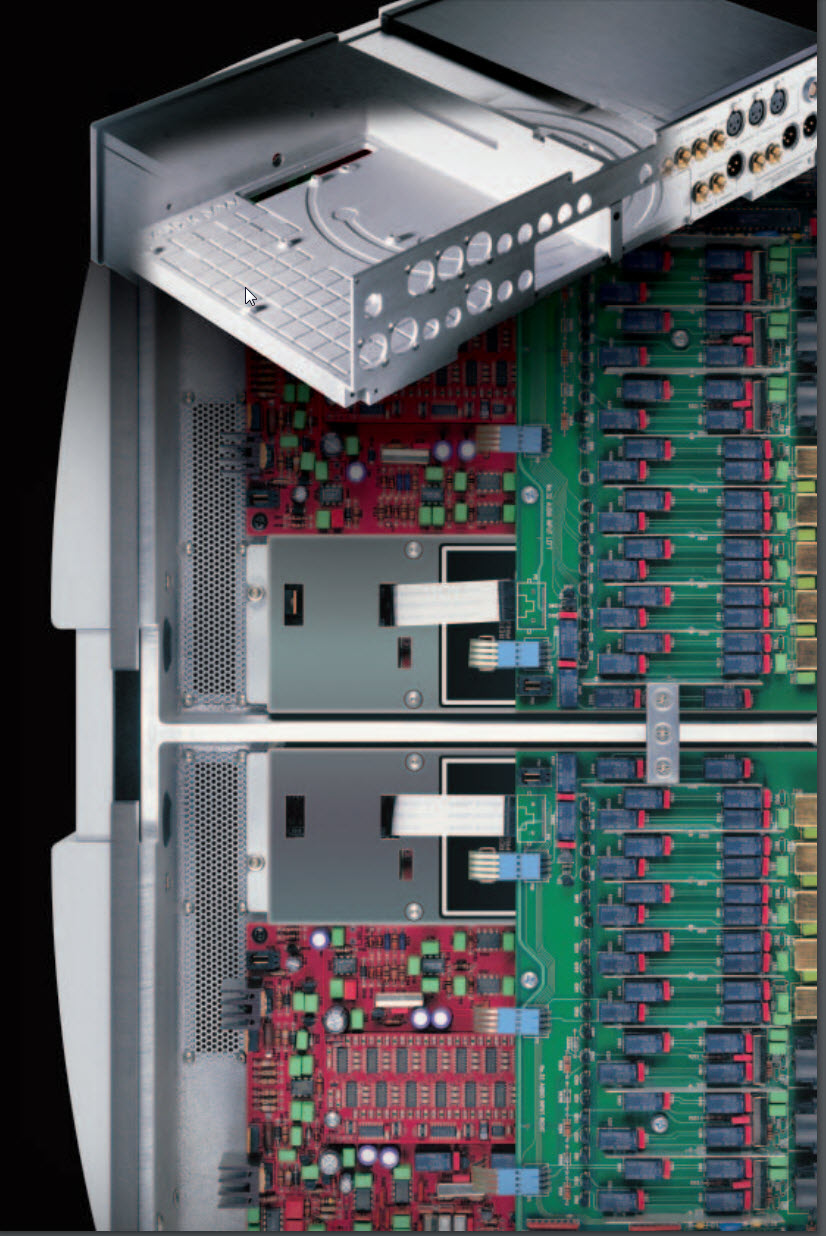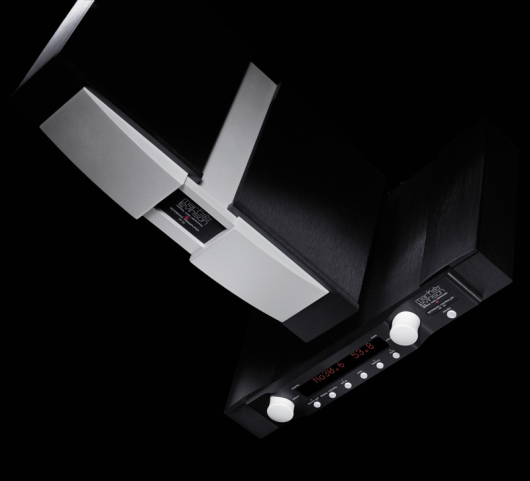


Separating power-supply and control circuitry makes sense in a modern, Reference-level preamplifier. AC power supplies, microprocessors, LED displays — essentially, anything that generates noise — are housed in a separate chassis from the low-level audio signals (the Nº32 Reference Controller), while all of the audio-preamplifier circuitry is housed outboard (the Nº32 Reference Preamplifier). Thus, the audio circuits are exposed only to quiet, regulated DC power and the audio signal itself.
Two master power supplies are located in the center section of the Reference Controller: one is dedicated to control and communications; the other is used for the audio circuits. The power from the AC line is pre-filtered, and the two master supplies are isolated from one another. The power supplies use custom-designed transformers featuring multiple secondary windings, which substantially improve isolation between separate circuit blocks. Separate rectification, filtering, and regulation circuits are used to supply DC to the control/communications circuits, a Nº25 phono DC supply output, and the 400Hz oscillator circuits used in power-supply regeneration.
The Nº32 employs AC power regeneration:
the DC supply feeding the voltage gain stages is
derived from an AC source generated within the
amplifier itself. This technique is expensive but
very effective. In the Nº32 Reference Controller, a
400Hz oscillator generates the AC source for the
preamplifier’s audio power.
Microprocessors are noisy devices which
can pollute low-level audio signals if care is not
taken to keep processing noise out of the signal
path. For this reason, the microprocessors in the
Nº32 are not only located in the controller box,
physically separated from the preamplifier chassis,
but are also within their own shielded box.
The microprocessors in the Nº32 control
volume changes, signal routing, and other switching
functions. They make it easy to name inputs,
select mono modes, set mute level, or program
offset or gain levels for individual inputs — all
from the front panel. Like other current Mark
Levinson components, the Nº32 uses a softwarebased
operating system that can be upgraded
through its RS-232 port.
buttons or knobs. The Reference Controller is
used to execute all commands through its simple
front panel. Each source can be named in the
display, and full control of all functions, with the
addition of mono/stereo selection and polarity
control, is available from the remote.
The Nº32’s casework is extraordinary even
by Mark Levinson standards, and, like the other
aspects of its design, reflects an uncompromising
2
approach. Its chassis is a custom aluminum
casting, machined and finished with a conductive
Irridite (clear chromate) coating. This design
approach assures a rigid, stable environment in
which vibration and microphonic effects are
controlled.
The left and right channels are separated by
a solid aluminum divider wall, formed as part of
the casting. Each channel is thus sealed into its
own environment to prevent the electromagnetic
noise of one channel from degrading the other.
Because each channel is effectively isolated from
the other electrically and physically, the Nº32’s
stereo separation is equivalent to that of two separate
mono preamplifiers.
The Nº32 is the first Mark Levinson product
to use Arlon 25N® for its circuit boards. This
material’s superb dielectric properties help the
Nº32 achieve remarkable performance with
complex audio signals. Arlon 25N was chosen
only after extensive listening tests revealed that it
was audibly superior to all other materials in this
particular application.
Both balanced and single-ended inputs are
provided on the rear panel. Single-ended signals
have common-mode noise (noise present on both
signal and ground) rejected at the input stage.
Fully balanced instrumentation amplifiers are
employed as the gain stages, and each input can
be separately adjusted using the software to offer
0, 6, 12 or 18dB of gain. Using this feature, the
Nº32 allows the volume control to work in its
optimum range even when its sources have
substantially different output levels.
While volume control is one of the primary
functions of a preamplifier, it is also a source of
compromise in many designs. The Nº32
introduces a new active attenuator: a discrete
design that offers an unprecedented combination
of precision and neutral sonic performance. The attenuator modules are constructed on their own
four-layer Arlon 25N circuit boards, whose local
power-supply regulation and bypass capacitors
guarantee the sensitive switches receive clean
power and optimum isolation. An array of precision
resistors provides attenuation in 0.1dB steps
down to –57dB, where step size is increased to
1dB. With over 65,000 steps available, the Nº32’s
stepped attenuator gives the required precision
while acting and sounding like a continuously
variable control.
High-performance buffer amplifiers form the
output of the Nº32. These circuits feature low
noise and distortion, low output impedance, high
current capability, and broad bandwidth. Singleended
and balanced outputs are independently
buffered to allow simultaneous use of both
connector types without sonic compromise.
For music lovers using analog disc sources,
the Nº32 offers optional phono modules shielded
in mu-metal that are easily installed via the rear
panel. Setting up and customizing the Nº32’s
phono stage is an analog lover’s dream. Its defeatable
infrasonic filter, resistive and capacitive
loading, and gain can all be selected independently
for each of its two inputs. It even has a fine-trim
adjustment for balance to compensate for the
small channel imbalance found in virtually every
cartridge. What’s more, all of these variables can be
adjusted from the remote control.

Its beautiful.
No matter how you look at it, from any angle. The guys didn’t skip the slightest on this machine. It looks almost as even the screws were made just for the REF32! The connectors are all ultra-quality, the chassis strong and solid. Use of slabs of aluminium. Its mix of black and grey, sombre but still standing out from the crowd. Mixing an extremely good looking minimalist look with massive feature set. It drips with quality, like a Bentley or Rolls-Royce.
It’s a Swiss army knife.
The Inputs.
All can be customized, gain set, name changed, SE or XLR. How nice is that ? You have XLR and RCA, you mix and match as it serves you. An NEVER any hum or distortion, anything! So many pre-amp try and cater for both XLR and Single Ended but do not spend the money to make the conversion proper, or the pre-amp is not designed to be balanced right through. The REF32 is both. Real balanced design right through. Costly exercise, but in the end worth it. You will not want for a more complete control over your system. Even more if you add the optional Phono nodules!
It Sings.
I would say it leans towards warmer, slightly darker, more romantic. No this is not a tube romance, but its not a solid state, utter revealing preamplifier as well. It never offends, always bring a smile to my face, a satisfaction of things done right and approachable. It doesn’t lack anything in the bass, its got a stunning midrange, and dare I say it, slightly sweet top end. Voices are stunning on it. It pairs incredibly well with my Krell.
Its Class A.
Unconditionally. There are more revealing pre-amplifiers. There are none as quiet. There are some with larger soundstages. There are some with more bass. More midrange bloom. But very few has it all to some sort of a degree. The REF32 will never disappoint. It’s the sure bet, to Go-To pre-amplifier. I would always use my time with it as reference for what a pre-amplifier should sound like and perform like.
Mark Levinson Reference 32
-
Features - 9.5/109.5/10
-
Style and Looks - 9/109/10
-
Soundstage - 7/107/10
-
Detail - 8/108/10
-
Midrange - 9/109/10
-
Bass - 9/109/10
-
Price - 6/106/10
Summary
Probably the best built preamp in the world. Overengineered, and will last a lifetime.
